Irish Folklore Creatures and Myths: An Exploration of Celtic Legend
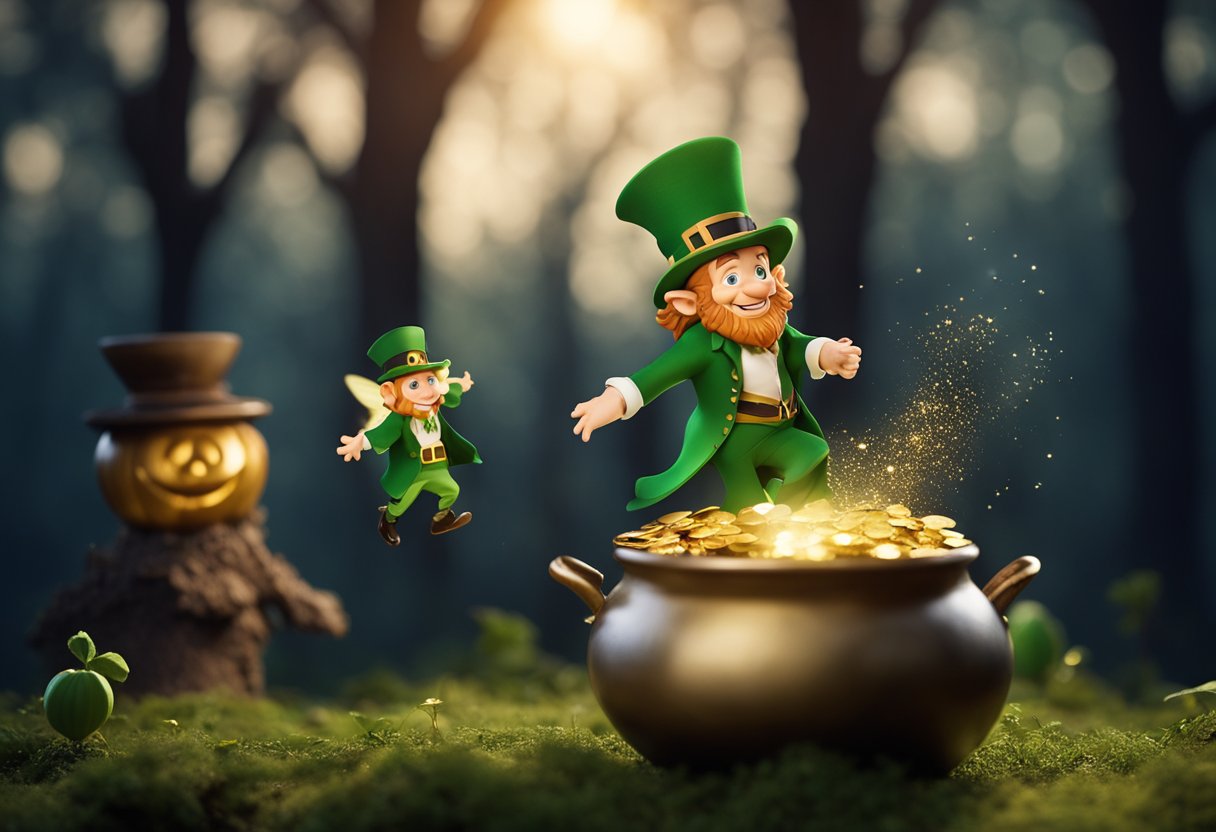
Updated On: April 23, 2024 by Maha Yassin
Ireland’s cultural tapestry is woven with the enthralling threads of Irish folklore creatures and myths passed down through generations. These stories form an integral part of the Irish identity and continue to captivate with their blend of the mystical and the historical. At the heart of these tales are the vibrant characters and creatures that populate Ireland’s mythical landscape, each embodying the island’s rich tradition and cultural history.
Through the mists of time emerge figures from the Aos Sí, the supernatural race thought to live in a parallel world, to legendary heroes whose bravery still echoes today. The tales of mythical monsters and adversaries, alongside famed artefacts and iconic characters, not only provide entertainment but also offer insights into the values and beliefs of the Irish people. These narratives of gods, heroes, and otherworldly beings give us a unique lens through which to view Ireland’s cultural history, tradition, and essence, infused with a sense of magic and storytelling prowess.
Origins of Irish Folklore Creatures and Myths
Irish folklore has a storied heritage, deeply rooted in the ancient past of Ireland and subsequently woven with the threads of Christian influence during the Middle Ages. We’ll explore how the tales and myths intrinsic to Irish culture emerged and evolved.
Influence of Ancient Ireland
Our myths are as ancient as Ireland, mirroring the complexity of early Irish society and its spiritual beliefs. Celtic mythology forms the backbone of our folklore, with stories of deities, heroes, and mystical creatures that epitomise the natural and supernatural world. These elements reflect a deeply pagan tradition that emphasised the animism of the natural world. During the Iron Age, these myths likely began to take shape and passed orally through generations, each narrative enriched by the teller’s artifice.
Christianity and Mythology Interwoven
With the arrival of Christianity in the early Middle Ages, our pagan ancestors faced a spiritual transition. However, rather than eradicating pre-Christian traditions, the new Christian ideologues intertwined them with biblical narratives. This melding of beliefs created a unique cultural tapestry in which Saint Patrick and ancient Irish mythological figures stood side by side. Monastic scribes were instrumental in this phase, diligently transcribing the orally recounted myths into texts. These texts, while Christian in perspective, preserved the essence of our mythological cycles, providing a lasting legacy of Ireland’s pre-Christian ideologies.
The Aos Sí and Otherworldly Beings
The Aos Sí represent a realm of Irish mythological entities intrinsically linked with the land’s natural landscape and ancient deities.
Nature of the Aos Sí
The Aos Sí are a pantheon of supernatural beings perceived in Irish folklore as the remnants of the Tuatha Dé Danann, the storied race of divine entities once inhabited Ireland. These ethereal beings reside within an Otherworld, a parallel dimension infused with magic and inaccessible to humans except through specific liminal places. They occupy a complex hierarchy, with some likened to elves in their stature and others bearing resemblance to Celtic gods and goddesses in their influence. It is customary to respect the Aos Sí and their abodes – to disrupt them is to invite misfortune.
The Sidhe and Fairy Mounds
Sidhe often interchanged with ‘Aos Sí’, also describes earthen mounds dotted across the Irish countryside where the Aos Sí dwells. These mounds, or fairy forts, serve as gateways to the Otherworld and are treated with wary respect by those who believe in their powers. It is said that the Sidhe safeguard the sacredness of nature, blurring the boundaries between our world and the realms beyond. Engaging with these sites is done with reverence, for the Sidhe hold sway over the land’s bounty and the welfare of those who live nearby.
Legendary Creatures and Heroes
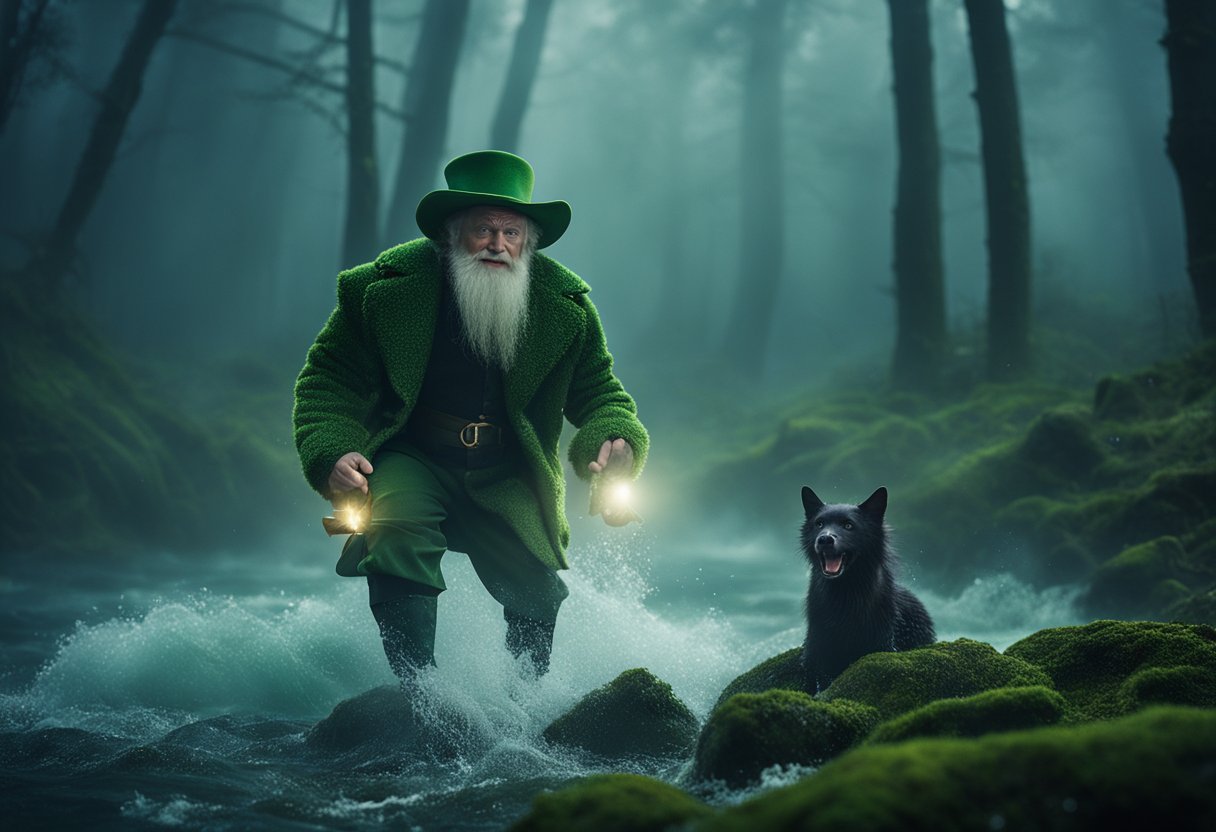
The line between history and myth is often blurred in Irish folklore, producing legends of heroes whose deeds have echoed through time. These tales not only captivate the imagination but also convey ancient Ireland’s values and fighting spirit.
Fionn Mac Cumhaill and the Fianna
Fionn Mac Cumhaill, the revered leader of the Fianna, is a central figure in Irish mythology. His adventures and the tales of his warrior band are detailed in the Fenian Cycle, where their bravery and battle skills are legendary. The Fianna were more than mere warriors; they were custodians of knowledge and protectors of Ireland, embodying the ideal traits of honour and strength.
The Formidable Cú Chulainn
Another towering figure of Irish lore is Cú Chulainn, known for his superhuman prowess and a key protagonist in the Ulster Cycle. From a young age, Cú Chulainn demonstrated extraordinary abilities that set him apart. His most famous deed, the defence of Ulster in the Táin Bó Cúailnge, showcases his might and the complex nature of heroism in Celtic mythology. His legacy as a paragon of valour continues to inspire awe and respect.
Mythical Monsters and Adversaries
In the rich tapestry of Irish folklore, numerous mythical monsters and formidable adversaries stand out for their malevolence and the terror they embody. Amongst these, the Fomorians and Balor of the Evil Eye are notorious for their roles as ancient enemies and symbols of destructive forces.
Fomorians: Ancient Enemies
The Fomorians are an ancient and dark race of supernatural beings in Irish mythology, often depicted as hostile and monstrous. They are said to have been the scourge of Ireland, with their tyranny representing the wild forces of nature and chaos. Hailing from beneath the waves or otherworldly islands, they frequently clashed with Ireland’s earliest settlers and later with the Tuatha Dé Danann, the pantheon of Irish gods.
Balor of the Evil Eye
Balor, a formidable Fomorian warrior and king, instilled fear with his poisonous eye that wrought destruction when opened. Legend has it that Balor could unleash his deadly gaze upon whole armies, laying waste to those who opposed him. His very presence epitomised evil in the Celtic myths, and it took a heroic effort from the Tuatha Dé Danann to bring about his downfall during the mythical Battle of Mag Tuired.
Famous Irish Folktales
Irish folklore brims with captivating tales passed down through generations, often encapsulating the essence of Celtic mythological creatures and the trials and heroics of ancient times. These stories are not just entertainment but a fundamental part of Ireland’s cultural heritage.
The Enchantment of the Children of Lir
The sorrowful tale of the Children of Lir is one of profound transformation and enduring love. It centres around the four children of King Lir, who were turned into swans by their jealous stepmother. Bound to live as swans for 900 years across various waters, they maintained their humanity through their enchanting songs Children of Lir: An Irish Legend.
The Tragic Lovers of the Deirdre Story
In the Deirdre story, tragedy intertwines with romance. Deirdre, destined to be the most beautiful woman, is sought after by many, including King Conchobar. She flees with her love, Naoise, to escape the king’s intentions. This story, part of the larger Fenian Cycle, recounts their pursuit and the heartrending outcome when fate catches up to them. Fenian Cycle: The Importance of Legends in Irish Culture.
Folk Beliefs and Superstitions
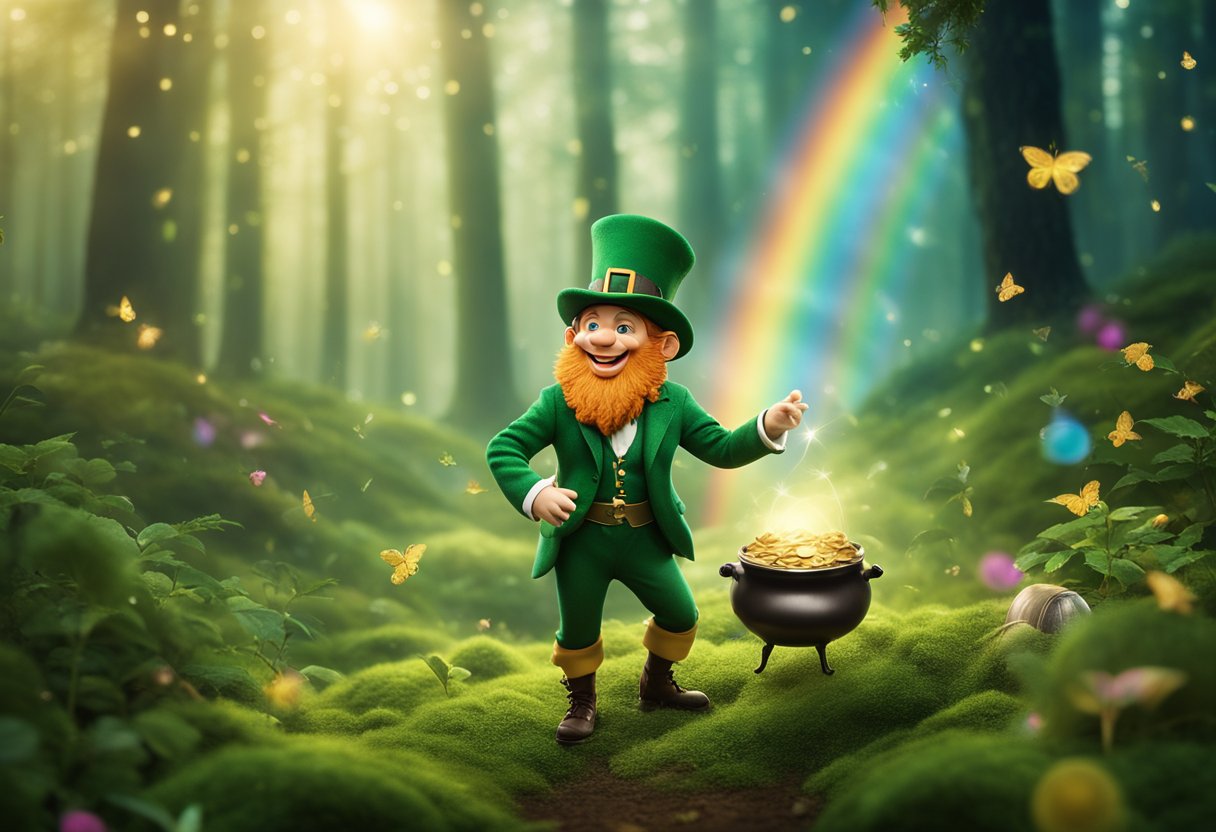
In our exploration of the rich tapestry of Irish folklore, we uncover various beliefs and superstitions woven into the very fabric of Irish culture. These range from protective charms to ominous portents that have captivated the hearts and minds of the Irish for centuries.
Protection and Curses
In Irish folklore, certain practices and talismans are vital for safeguarding against evil forces. For instance, iron is believed to be a powerful deterrent against fairies, who are notorious for their tricks and mischief. People would place an iron object, such as a horseshoe, over their door to ward off these mischievous sprites.
Another common practice is hanging rowan trees near homes. This tree is considered sacred and is thought to offer protection against enchantment and curses. It is common to encounter stories of intricate charms and spells, highlighting the profound belief in the supernatural and the measures taken to prevent its evil influence.
Omens of Death and Good Fortune
Omens and portents play a critical role in Irish folklore, with certain events or encounter indicators of impending death or good luck. The most renowned of these is undoubtedly the Banshee. With her mournful wail, the Banshee is believed to foretell the death of a family member, often appearing as a veiled woman or an old hag.
Conversely, a chance meeting with a leprechaun, typically depicted as a diminutive, bearded man, could lead to good fortune, provided you can catch him and claim his legendary pot of gold. It is important to note, though, that leprechauns are also considered tricksters, so any dealings with them should be cautiously approached.
This brief excursion into Irish folklore provides a glimpse into a complex world where the natural and supernatural coexist. These folk beliefs and superstitions offer crucial insights into the Irish way of life, reflecting both an ancient connection to the land and the enduring nature of the stories that have been passed down through generations.
Iconic Folklore Characters
In this section, we explore some of the most emblematic figures that populate the rich tapestry of Irish mythology, creatures known for their distinct traits and the captivating stories woven around them.
Leprechauns: Mischievous Fairy Folk
Leprechauns have become synonymous with Irish folklore, renowned for their cunning and the secretive nature with which they guard their fabled pots of gold. Often depicted wearing green coats and hats, these solitary fairies are considered skilled cobblers. Should you be lucky enough to capture one, it’s believed that they might grant you three wishes in exchange for their freedom.
The Wailing Woman: Banshee
Banshees are amongst the most haunting presences in Irish lore. Known as the harbingers of death, their mournful cries are taken as an omen that a family member will soon pass away. Usually appearing as women dressed in white with flowing red hair, the banshee’s wails serve as a poignant reminder of the inevitability of death and the connections to the otherworld within Irish myth.
Legendary Artefacts and Objects
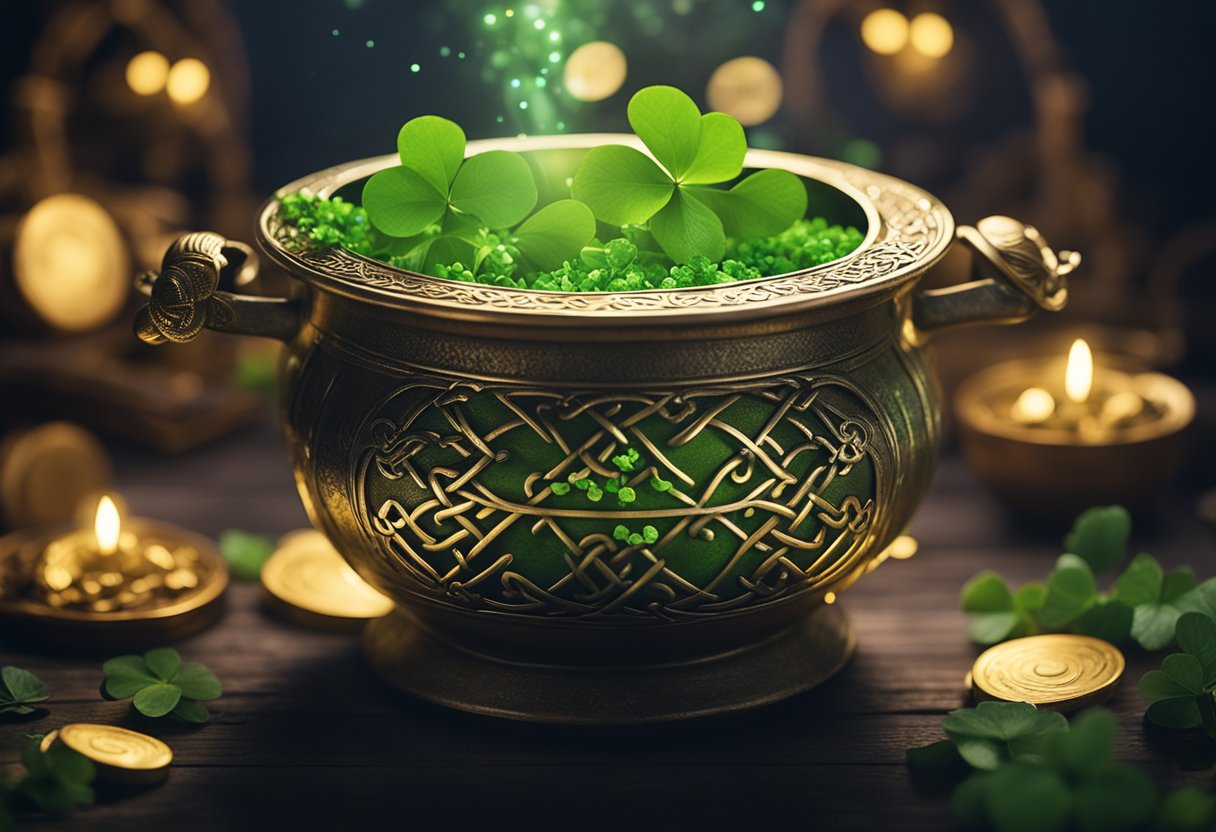
Within the expansive realm of Irish mythology, artefacts and objects hold immense importance, often being credited with supernatural attributes, and are pivotal in various mythological tales.
The Four Treasures of the Tuatha Dé Danann
Our exploration begins with the Four Treasures of the Tuatha Dé Danann, legendary items each representing one of the four cities from which the Tuatha Dé Danann came to Ireland. They brought with them the Sword of Light, which no one ever escaped from once drawn from its sheath, and the Stone of Fal, which roared when touched by the true king of Ireland. The Spear of Lugh ensured victory to its bearer, and the Cauldron of Dagda was said to leave none unsatisfied. These items significantly shaped the events within the Irish mythological cycle, especially during battles and kingships.
- Sword of Light: Ensures an escapable defeat.
- Stone of Fal: Recognises true sovereignty.
- Spear of Lugh: Guarantees victory to the wielder.
- Cauldron of Dagda: Provides endless sustenance.
Symbolic Items in Tales
Moving on to Symbolic Items in Tales, we refer to mementoes as the array of enchanted items in the Cattle Raid of Cooley, a central epic from the Ulster Cycle. The Comb and the Failinis, are examples of such artefacts. The Comb, often related to feminine beauty and sovereignty, also plays a role in betrothal and marriage customs within the stories. The Failinis, a mystical dog belonging to the son of the sea god Manannán mac Lir, was known for its healing tongue and ability to turn water into wine. Such objects are more than mere possessions; they hold significant power and symbolism in the narratives, reflecting the values and beliefs of ancient Irish culture.
- Comb: Symbolic in rites of passage and marriage.
- Failinis: A dog possessing miraculous healing abilities and transformative powers.
Folklore in Literature and The Arts

Irish folklore has left an indelible mark on literature and the arts, infusing them with the mystical essence of Ireland’s cultural heritage.
Influence on Irish Literature
Irish folklore has been a wellspring of inspiration for writers, from the gothic tales of Bram Stoker to ethnographer Patrick Weston Joyce. Stoker’s seminal work, Dracula, is entrenched in the mythos of the Irish vampire, reflecting Ireland’s rich mythological past impacting the literary world. On the other hand, Joyce’s comprehensive work on Irish music and traditions encapsulates the profound impact of folklore on the nation’s cultural narrative.
Music and Dance Traditions
Music and dance have long been vessels for the transmission of Irish folklore, harnessing both the melodic and the rhythmic to recount tales of old. The timeless presence of folklore in Irish music is evident, offering more than mere entertainment—it’s a living echo of Ireland’s folkloric culture. Traditional dances bring to life the stories and characters of Irish myths, with each step and tune passed down through generations.
Folklore’s Place in Modern Ireland
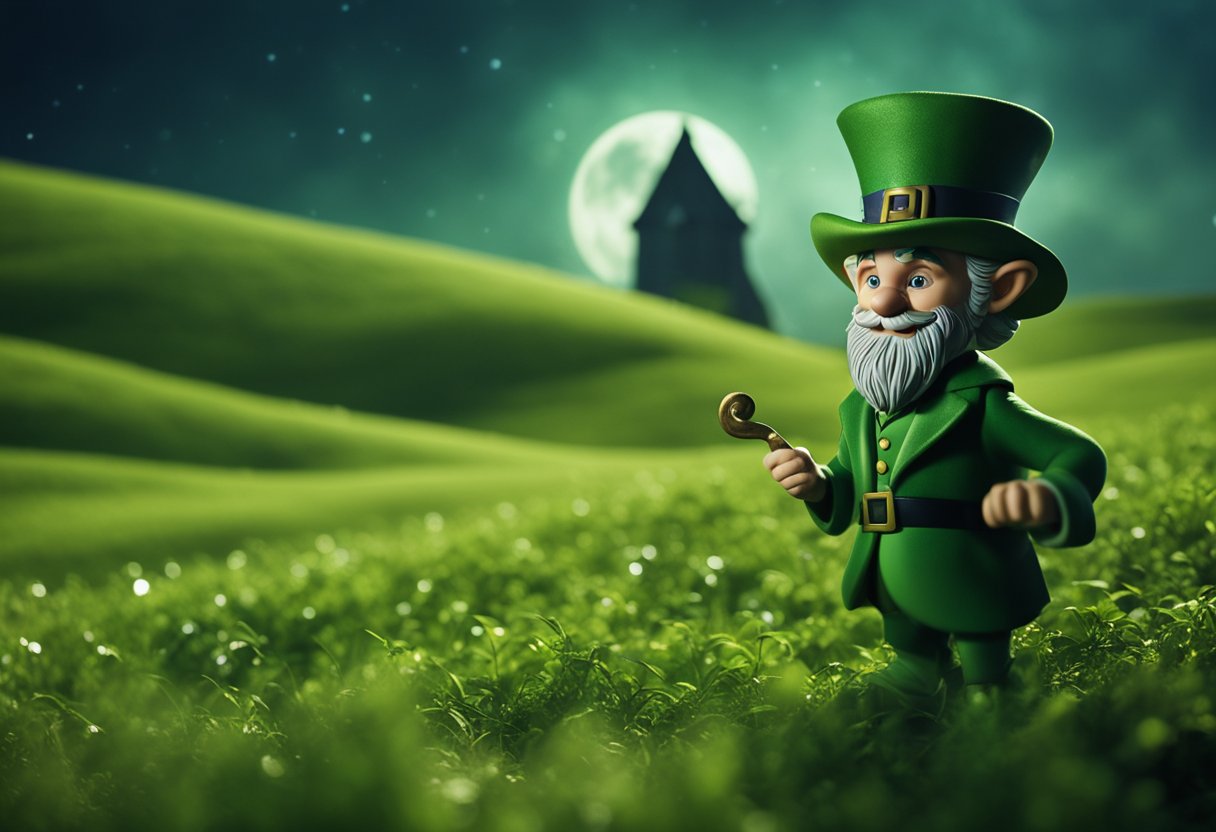
Irish folklore, steeped in myth and tradition, continues to permeate the cultural fabric of modern Ireland, playing a vital role in preserving heritage and shaping contemporary Irish identity.
Preservation and Change
Ireland’s dedication to folkloric preservation is seen in the careful curation of tales and myths passed down through generations. Organisations such as the National Folklore Collection, which documents and archives the country’s mythological heritage, ensure the continuity of Ireland’s storied past. Tales of fairies, leprechauns, and mythical beings like the Oilliphéist, found in the murky waters of lakes and rivers, are meticulously recorded and safeguarded.
Traditions in places like Derry continue to resonate, illustrating the bonds between folklore and local customs. The legacy of individuals like Patrick Weston Joyce, a prominent historian who collected and published Irish music and folklore, has been instrumental in this preservation effort. Through books, music, and festivals, the tales once shared by the fireside are now retold in modern mediums, ensuring their survival in a rapidly changing world.
Folklore’s Role in Irish Identity
For the Irish, folklore is not merely a collection of stories; it represents a fundamental aspect of their national identity. Myths and legends form an intrinsic part of the Irish culture, influencing everything from literature to everyday life and instilling a sense of pride and continuity among the Irish people. Places of noted folklore, such as the Giant’s Causeway or the Hill of Tara, are not just tourist destinations but sacred sites that embody the Irish’s spirit and resilience.
Folklore is recognised as a pivotal element of Irish heritage in schools and cultural institutions. Its profound impact shapes the perception of Ireland at home and abroad. The narratives of Irish folklore continue to shape community values and provide a shared narrative that resonates with the Irish diaspora worldwide, reinforcing a global connection to the Emerald Isle.
Frequently Asked Questions
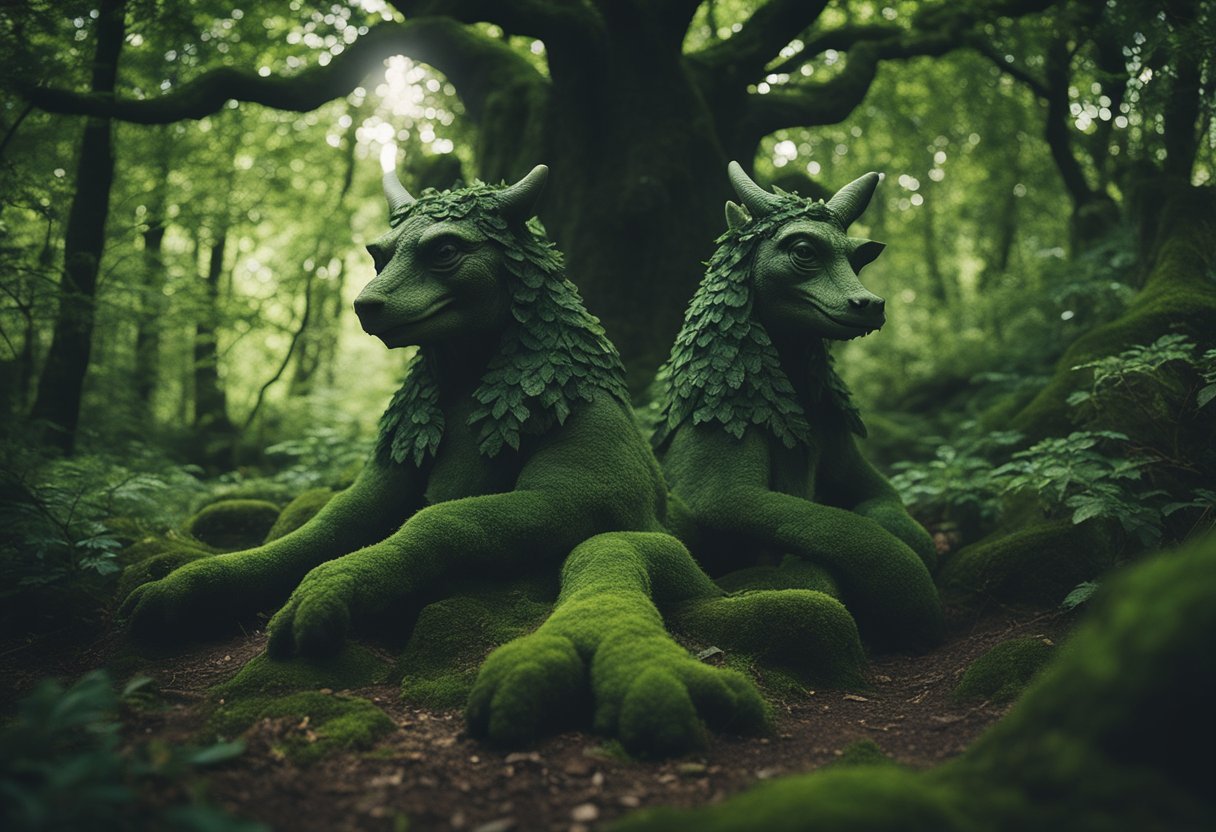
This section addresses the common curiosities surrounding the mystical beings and narratives that define Irish lore.
Who are the prominent figures in Irish mythology?
Prominent figures in Irish mythology include the likes of the Dagda, the father figure of the gods, and the warrior Cú Chulainn, renowned for his superhuman strength and valour. Famed queen Medb is also central to these tales, known for inciting the Cattle Raid of Cooley.
Can you name some notable sea creatures in Celtic myths?
Notable sea creatures in Celtic myths embrace the fearsome sea serpent, the Oilliphéist, which is said to have carved out the route of the River Shannon. The shape-shifting Selkie, seals that can transform into humans, are also integral to maritime mythology.
What are the most infamous demonic entities in Irish folklore?
Among the most infamous demonic entities in Irish folklore are the Balor, a fearsome giant with a destructive eye, and the mischievous Púca, known for its shape-shifting trickery. The malevolent Sluagh, spirits of the restless dead, are also notorious for their wickedness.
Which mythological tales are considered essential to Irish cultural heritage?
Tales deemed essential to Irish cultural heritage include the epic Táin Bó Cúailnge (The Cattle Raid of Cooley) and the tragic story of the Children of Lir, who were turned into swans. The adventurous Immram Brain (Voyage of Bran) is also a key narrative, exploring the otherworldly islands off Ireland’s coast.
What creatures make up the folklore traditionally shared with Irish children?
Irish children are often regaled with tales of the gentle Aos Sí, fairy folk dwelling in the otherworld, and the lone-wailing Banshee, believed to foretell death. Leprechauns’ mischievous cobblers with hidden gold pots also capture young imaginations.
Could you identify female mythological entities from Ireland?
Female mythological entities from Ireland include the Morrígan, a powerful goddess of war and fate, often associated with crows and ravens. Áine, the queen of the fairies and a summer goddess, is revered for her associations with love, fertility, and sovereignty.






